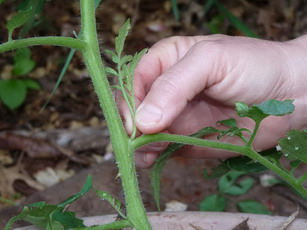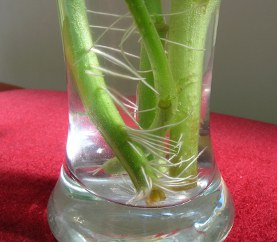Introduction
- Sun and heat
- Fertilizer
- Carefully select the breed
- Prune and support
- Water correctly
- Limit Disease
- Bury deep
I describe each one of these important aspects of tomato growth in detail below.
Sun and Heat
Tomatoes, originating from central America, are tropical plants, and require significant amounts of heat and sunlight. Tomatoes require 8-10 hours of direct light to grow and fruit properly. In high-heat areas, it may be good to partially shade fruit-bearing tomato plants in the afternoon to prevent the fruit from being scalded by the sun.
 |
| Shade for plants on a hot day. From: http://angelvalleyfarm.wordpress.com |
Tomatoes require warm weather to grow fruit, and definitely do not tolerate cold weather well (with the exception of some special breeds). Northern Utah has a frost-free period of about 140 days, which isn't much time to grow things like tomatoes, especially when you want to keep the tomatoes coming.
One way to extend the growing season is by housing your tomato plants in a high or low tunnel. Tunnels allow for heat retention at night when temperatures drop. They also keep rain off of the plants, which decreases incident of foliar (leaf-based) diseases. While tunnels and row covers do prolong the growing season, they can limit the amount of usable solar energy available, and increase humidity, which can in turn increase disease. To built a self-ventilating tunnel, check out this blog post.
 |
| Examples of low tunnels from The Organic Gardener. |
While some would argue that it deters from true organic gardening plastic mulch has been proven to increase yields in tomato plants. Mulch in general is a good idea for all gardens, as it helps the soil retain heat and moisture. Soil heat is very important for generating good fruit yields.
For more information about tunnels and tomatoes, check out these links:
- The best time to grow tomatoes from the LA Times
- Tomatoes in low tunnels on Gardenweb forums
- Technical presentation on the benefits of low tunnels
- Excellent Thesis on the application of high tunnels to tomatoes in Utah
- Light requirements for tomatoes on Gardenweb forum
- Information on plastic mulches
Fertilizer
Tomatoes are known as "heavy feeders" and require a significant amount of nutrients to grow. Keep in mind that certain types of plant fertilizer or excessive amounts of fertilizer can "burn" the plants, which can hurt your yield.If you are serious about growing massive amounts of massive tomatoes, then I suggest starting the fertilizing process by getting your garden soil tested by your local extension service. Utah State University provides extension services in Utah, including soil testing.
The most important nutrients in the vegetable gardening world are nitrogen, phosphorous, and potassium. These nutrients are commonly listed on fertilizer bags as N-P-K (see below). Basically, nitrogen assists the plants in leafy growth, phosphorous increases fruit and flower production, and potassium supports root development. Gardenstuffs has a good summary of what types of nutrients plants need and when to apply them.
 |
| The Zone 10 website has an excellent illustration and description on how to read the numbers on fertilizer bags. |
In terms of tomato growth, I suggest using nitrogen and potassium-rich fertilizer when you first plant the tomatoes, then using phosphorous-rich fertilizer when the flowers and fruits are beginning to develop. Using too much nitrogen later in the tomato plant's life cycle will create abundant leafy growth, which robs energy from fruit development. Calcium is also a good supplement for tomatoes, as it reduces blossom rot. It should be amended into the soil when the tomato seedling is planted.
I like using the following organic fertilizers for my tomatoes, as suggested in the video below:
- Kelp Meal - Nitrogen and Potassium
- Agricultural Gypsum - Calcium
- Cottonseed Meal - Nitrogen-rich, slow release
- Bone Meal - Very Phosphorous rich
- Fish Meal - A lot of nitrogen, some phosphorous
As a note based on a comment I received on this post, I should mention use epsom salt as applied to the soil or as a foliar spray. Studies have shown that applying dilute epsom salt could promote plant vigor and make for larger fruits. There is still some question as to how effective this is, but it doesn't hurt! Read this article from the National Gardening Association for more information.
Watering
The best way to water tomatoes is via a drip irrigation system. Overhead watering systems make the leaves wet, which could promote fungal growth. Tomatoes are heavy drinkers and require water frequently and at extremely regular intervals. There is some debate as to the quantity of water applied. I have talked to a couple of gardeners that recommend an inch per week. Tomatodirt has some excellent tips on watering. I water three times per week for two 20-minute intervals. I do two separate intervals to allow the water time to infiltrate into the soil. I talk about my irrigation system in this post.
Tomato Types
Sauce, Slicer, and Cherry
In terms of what the tomato will be used for, there are three main categories: sauce, slicer, and cherry. Slicers are big and beefy, appropriate for sandwiches. Sauce tomatoes has less water content and are commonly used for sauces and pastes. Cherry tomatoes are self explanatory.
Indeterminate vs. Determinate
The differences between these two categories of tomato will be important when supporting your tomatoes. Indeterminate tomatoes will have fruits that ripen at different times, and they will continue to grow until the first frost. Indeterminate tomatoes can be trained to grow vertically. Determinate tomatoes are more bushy and have fruit that ripens all around the same 2-3 week interval. The following video describes the differences between determinate and indeterminate tomatoes.
Heirloom vs. Hybrid
Heirlooms are seeds that have been selected from the best performing plants for several generations. Hybrids are from different varieties that have been intentionally cross-pollinated. Heirlooms generally have better flavor, but hybrids are generally more disease resistant. You can reuse the seeds of your heirloom fruit knowing that they will essentially grow the same variety of tomato, but hybrids may produce different results. I usually grow both heirlooms and hybrids so that I do not put all of my eggs in one basket.
Heirloom related links:
- Bonnieplants on heirlooms and hybrids
- Scientificamerican's case against heirloom tomatoes
- USA Today comparing heirloom vs. hybrid
- Tomatodirt on heirlooms
- Wiki on heirlooms
Varieties
There are hundreds of varieties of tomato. Rutgers New Jersey Agricultural Experiment Station has a huge list of tomato varieties. It is important to take some time and talk to local gardeners and your extension agents to see what varieties do best in your region. Mother Earth News provides some guidance as to what varieties do be in the Utah region and other parts of the United States.
Prune and Support
 |
| Suckers grow between the main stem and the side stems. from: http://www.tomatodirt.com/pruning-tomato.html |
If pruned and supported properly, indeterminate tomatoes can produce insane amounts of tomatoes. I recently summarized plant supports in this post. Lately, I have been favoring the string and sucker technique in growing tomatoes.
Prune the suckers from the tomato plants. Suckers grow between the main stem and the branches. They can divert important nutrients away from the fruits. It is especially important to prune suckers if you are planning on using string as a support for your tomato plants.
Determinate varieties of tomato plants do not require such rigorous pruning. For these, I suggest large, sturdy tomato cages. The organicgardening website has excellent instructions on constructing sturdy cages from cattle panel. Most of the panels for sale at the hardware stores are inadequate.
Some other links regarding tomato support:
- Finegardening has a good video on pruning tomatoes to a single stem.
Limit Disease & Pests
I am not well versed on dealing with insects and fungus yet, but I do know a couple of tips regarding this:
Prune the suckers from the tomato plants. Suckers grow between the main stem and the branches. They can divert important nutrients away from the fruits. It is especially important to prune suckers if you are planning on using string as a support for your tomato plants.
Determinate varieties of tomato plants do not require such rigorous pruning. For these, I suggest large, sturdy tomato cages. The organicgardening website has excellent instructions on constructing sturdy cages from cattle panel. Most of the panels for sale at the hardware stores are inadequate.
Some other links regarding tomato support:
Some other links regarding tomato support:
- Finegardening has a good video on pruning tomatoes to a single stem.
Limit Disease & Pests
- Rotating your tomato crops not only limits disease, but it also allows for soil rehabilitation between crops.
- Limiting moisture on the leaves will significantly reduce fungus from growing on the leaves.
- Trimming off leaves that look diseased or curled might also limit the spread of disease.
Bury Deep
Roots of a plant take in nutrients and provide the plant with water. Unlike some other plants, if you bury the stem of the tomato plant, it will produce roots.
 |
| root growth from tomato stems from: http://www.tomatogrowing.co.uk/topical-tomato-tips |
Burying the stem of the tomato plant allows for additional root growth, which in turn allows for greater water and nutrient uptake. Some suggested burying the stems horizontally. At first I thought this was a wacky idea, but then I realized that burying the stems horizontally allows for root growth in the warmest, wettest, and most nutrient rich part of the soil.
When transplanting your tomato plants, make sure to remove the peat pot, as it can inhibit root growth. Also, if the plant is rootbound, then it is good to cut the bottom off of the root ball or criss-cross the root ball.
rootbound.This website has a good explanation of trench-planting tomato plants.
Summary
Here are a few links to learn some more tips on growing tomatoes:
- The Wikipedia article on tomatoes is worth reading
- Organic Gardening Secrets to Tomato Success
- Planet Natural Tomato Gardening Guru
- Tomatofest
- More growing tips from Organic Gardening
The video below contains an excellent set of tips on planting depth, organic fertilizer, addition of calcium, and removal of horn worms:



There's a lot of good information here Paul! Have you ever tried using epsom salt for you tomatoes? I heard the magnesium can help produce a better yield. This might be a myth though...
ReplyDeleteI came across epsom salt applied to flowers and wondered if it carried any merit. I might try it next season. This article talks about epsom salt and some of the studies conducted: http://www.garden.org/articles/articles.php?q=show&id=68&page=2
ReplyDelete